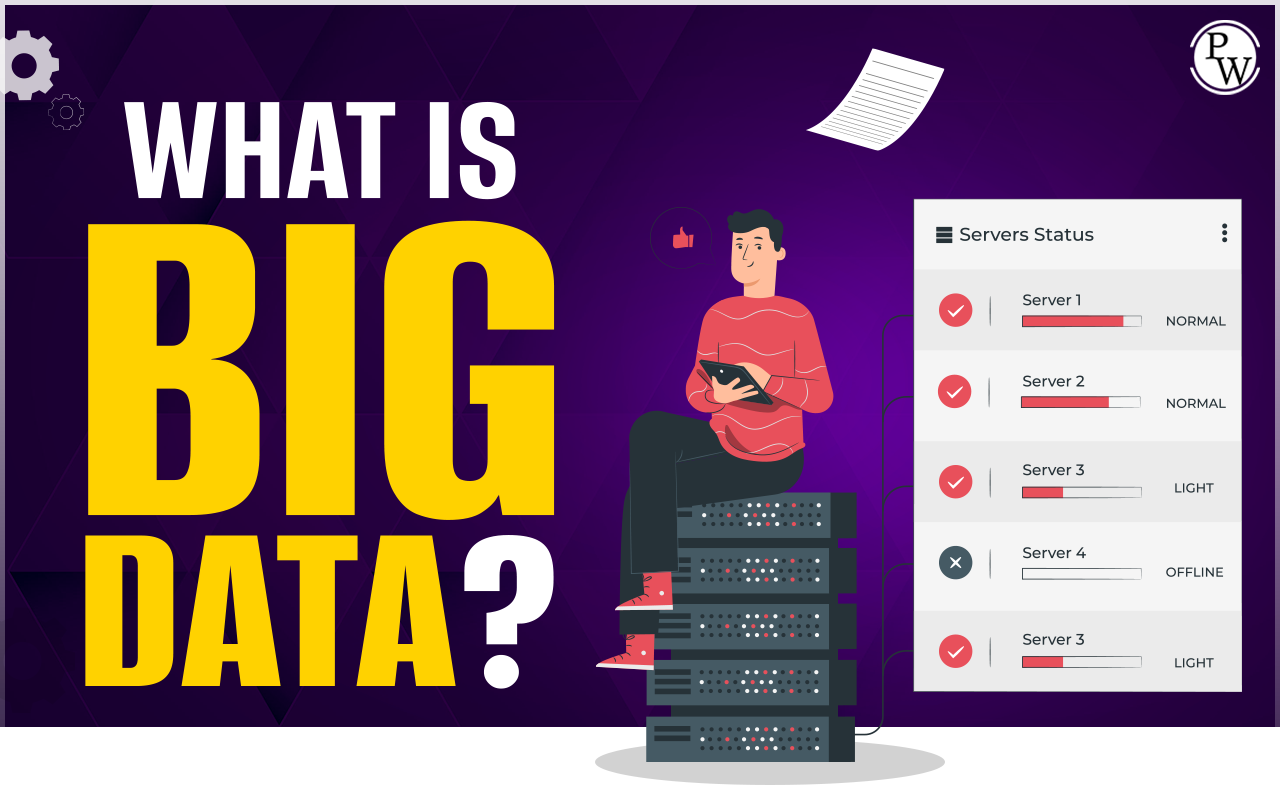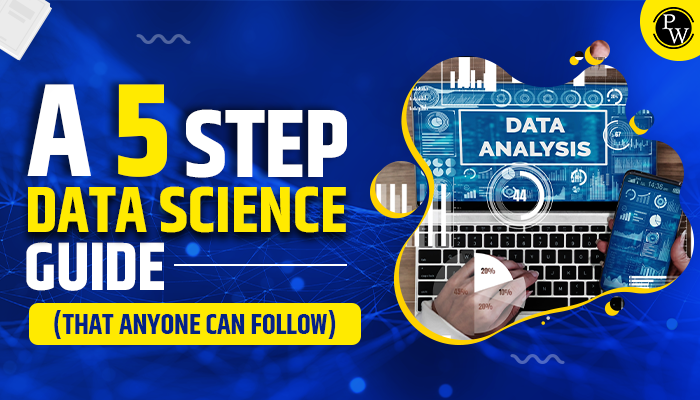Big Data in Data Science: In the ever-evolving landscape of technology, data has become the lifeblood of decision-making, innovation, and progress. At the forefront of this data-driven revolution lies the concept of “Big Data,” a term that has gained immense prominence in recent years. In this blog, we will tell you all there is to know about Big Data in Data Science, its benefits, how it works, examples, and more!
If you want to start a career in data science, a Full-Stack Data Science Course can give you a head start!
What Is Big Data in Data Science?

Big Data in Data Science is the handling of vast, complex datasets that surpass traditional processing capabilities. It involves collecting, processing, and analysing massive volumes of information to extract valuable insights, patterns, and trends, enabling informed decision-making and driving innovation in diverse fields.
Also Read: 10 Most Popular Big Data Analytics Software in 2023
The Three Vs of Big Data in Data Science
Volume
Big Data involves an immense volume of information. Conventional databases and processing systems struggle with the vast datasets from businesses, individuals, and connected devices. The data not only is extensive but also grows at an unprecedented pace. Coping with this surge in data necessitates scalable and efficient solutions for storage and processing.
Consider the petabytes of data from social media, e-commerce, sensors, and more. Tapping into this vast volume requires advanced tools for storing, managing, and analysing such colossal datasets.
Variety
Variety is another key aspect of Big Data, covering structured, unstructured, and semi-structured data. Traditional databases excel with structured data neatly organised in tables and rows. However, the digital era introduces diverse data types like text, images, videos, social media posts, and sensor data.
This diversity challenges traditional relational databases in handling unstructured data effectively. To address this, Big Data technologies like NoSQL databases and data lakes have emerged, offering flexible storage solutions capable of managing various data types.
Velocity
Velocity matters in data – how fast it’s created, handled, and examined. In our swift world, making decisions in real-time is vital for businesses. Think of financial dealings, social media engagements, or data from IoT sensors – they all create streams needing instant consideration.
The velocity of data necessitates advanced processing capabilities to extract insights in real time. Technologies like stream processing and complex event processing enable organisations to analyse and respond to data as it is generated, ensuring timely and informed decision-making.
The Value and Truth of Big Data
In today’s digital era, data floods in relentlessly from all corners of our interconnected globe. Big Data’s importance is immense. It’s not just about the sheer amount; it’s the profound insights and revealed truths within the vast sea of data that render it crucial for organisations and decision-makers.
Unlocking Insights Amidst the Vastness
Big Data’s core value lies in uncovering insights missed by traditional analytics. The vast array of data sources creates an intricate tapestry of information. Exploring this wealth enables businesses to extract valuable insights on customer behaviour, market trends, and operational efficiencies.
For instance, consider an e-commerce giant analysing customer interactions across its platform. The massive volume of transactional data, combined with user behaviour on the website, can reveal patterns that lead to more personalised marketing strategies. By understanding the nuances of individual preferences, businesses can tailor their offerings, enhancing customer satisfaction and driving revenue growth.
Making Informed, Data-Driven Decisions
Big Data transforms decision-making from a speculative art into a science. The insights derived from large datasets empower organisations to make informed, strategic decisions based on evidence rather than intuition. In various fields like healthcare, finance, manufacturing, and retail, the pivotal key to triumph is now rooted in decisions guided by data.
Consider healthcare: examining patient data and medical records enables professionals to pinpoint disease trends, foresee possible outbreaks, and customise treatment strategies for improved patient results. The significance goes beyond scrutinising individual patient data; it extends to the collective insights drawn from extensive datasets, shaping effective public health approaches.
Enhancing Operational Efficiencies
Big Data does more than just foreseeing future trends; it also enhances ongoing operations. Organisations can use data analytics to make processes smoother, cut down inefficiencies, and boost overall effectiveness.. Supply chain management, for instance, benefits greatly from the insights derived from Big Data analytics.
When businesses analyse information on stock levels, supplier efficiency, and shifts in demand, they gain precise forecasts on restocking timing, supplier importance, and how to refine the entire supply chain for efficiency. This not only saves costs but also guarantees businesses meet customer demands with greater efficiency.
The Veracity of Big Data: Truth Amidst the Noise
Big Data holds clear value, yet stressing data veracity, its truthfulness, is crucial. Decision-making integrity relies on the dependability of the data under analysis. In an age of diverse and dynamic data sources, ensuring accuracy and trustworthiness becomes paramount.
Data veracity encompasses concerns related to data quality, completeness, and potential biases. Inaccurate or incomplete data can lead to flawed analyses and, consequently, misguided decisions. Therefore, organisations investing in Big Data analytics must prioritise data quality assurance processes, data governance, and ethical considerations.
Navigating the Big Data Landscape with Responsible Analytics
In the pursuit of value from Big Data, organisations must approach analytics with responsibility and mindfulness. This task involves not only following ethical guidelines but also considering the wider societal impacts of data-driven decisions. Responsible analytics means being transparent, fair, and accountable when using data. To ensure the fair distribution of Big Data benefits and the reduction of potential biases, a proactive approach is necessary. Data scientists and analysts play a crucial role in fostering responsible analytics by constantly evaluating and challenging the assumptions underlying their models, identifying potential biases, and advocating for ethical practices within their organisations.
The History of Big Data
Understanding the past and future of Big Data requires exploring its historical journey. Big Data’s origins trace back to early computing when data volume was measured in kilobytes, not petabytes.
During the 2000s, “Big Data” gained popularity as organisations dealt with growing and varied datasets. Apache Hadoop, an open-source system for storing and processing extensive datasets across multiple locations, significantly contributed to the initial establishment of Big Data infrastructure.
Entering the 2010s, internet growth, combined with mobile devices and sensors, caused a data explosion. Cloud computing further boosted Big Data adoption, offering scalable and cost-effective solutions for storage and processing.
Today, Big Data is vital for digital transformation across industries. Its evolution continues with machine learning, artificial intelligence, and edge computing reshaping Big Data’s possibilities and applications.
Big Data in Data Science Use Cases
The applications of Big Data are as diverse as the types of data it encompasses. Across industries, organisations leverage Big Data to gain a competitive edge, optimise operations, and enhance customer experiences.
Healthcare
In the healthcare sector, Big Data is revolutionising patient care, research, and disease management. Electronic health records, medical imaging, and genomic data contribute to vast datasets that can be analysed to improve diagnostic accuracy, personalise treatment plans, and advance medical research.
Finance
The financial industry relies heavily on Big Data for fraud detection, risk management, and customer insights. Analysing vast amounts of transaction data in real time enables financial institutions to identify unusual patterns and potentially fraudulent activities.
Retail
E-commerce platforms harness Big Data to understand customer behaviour, optimise pricing strategies, and personalise recommendations. The analysis of purchase history, browsing patterns, and social media interactions enables retailers to create targeted marketing campaigns and enhance the overall customer experience.
Manufacturing
In manufacturing, Big Data is employed for predictive maintenance, quality control, and supply chain optimization. Sensors embedded in machines collect real-time data, allowing manufacturers to identify potential equipment failures before they occur, reduce downtime, and streamline production processes.
Smart Cities
Cities are becoming smarter with the integration of Big Data for urban planning and management. Data from sensors, traffic cameras, and citizen interactions are analysed to optimise transportation systems, improve energy efficiency, and enhance public services.
Also Check: Top 25 Big Data Interview Questions and Answers
Big Data in Data Science Challenges
While the benefits of Big Data are substantial, organisations must navigate several challenges to unlock its full potential.
Privacy Concerns
The vast amount of personal data being collected raises concerns about privacy and data security. Striking a balance between leveraging data for insights and protecting individuals’ privacy is a delicate challenge.
Security Issues
As the volume of data grows, so does the risk of cyber threats and attacks. Securing Big Data infrastructure and implementing robust cybersecurity measures are critical to safeguarding sensitive information.
Ethical Considerations
Big Data usage prompts ethical concerns regarding the collection, utilisation, and sharing of data. Entities must create ethical standards and procedures to guarantee the responsible and transparent handling of data.
Data Quality
The credibility of Big Data holds utmost importance. Flawed insights and decision-making can result from inaccurate or incomplete data. Instituting standards for data quality and governance processes is crucial to uphold the integrity of Big Data analytics.
How Big Data Works?
Fundamentally, Big Data processing revolves around gathering, storing, and scrutinising immense data volumes to derive significant insights. The typical process encompasses these steps:
Data Collection
Data is sourced from various channels, including sensors, social media, customer interactions, and more. The diverse nature of Big Data requires careful consideration of data types and sources.
Data Storage
Traditional relational databases are often inadequate for handling Big Data. Instead, organisations use distributed storage solutions like Hadoop Distributed File System (HDFS) or cloud-based storage to store massive datasets.
Data Processing
Big Data processing platforms, such as Apache Spark, are used to analyse and process data at scale. Parallel processing and distributed computing enable efficient handling of large datasets.
Data Analysis
Advanced analytics tools and algorithms are applied to extract insights from the processed data. Machine learning and artificial intelligence play a crucial role in identifying patterns, trends, and correlations.
Visualisation and Interpretation
The final step involves presenting the analysed data in a comprehensible format. Data visualisation tools help translate complex insights into actionable information for decision-makers.
Big Data Best Practices: Navigating the Data Deluge
Big Data offers unparalleled chances for organisations to extract valuable insights, optimise operations, and make informed decisions. To unlock its full potential, businesses must follow a set of best practices addressing the unique challenges posed by the sheer volume, variety, and velocity of data. In this section, we’ll explore these best practices, emphasising scalability, data quality assurance, security measures, and adopting an agile analytics approach.
Scalability
Scalability is crucial. As data volumes surge, Big Data infrastructure must seamlessly scale. Organisations should design their data systems with scalability in mind from the start. Scalability ensures that as data grows, the system can adapt and expand to meet increased demand without compromising performance. Using distributed computing architectures, like Apache Hadoop or cloud-based solutions, enables organisations to distribute data processing across multiple nodes. This not only boosts scalability but also allows parallel processing, significantly improving the speed and efficiency of data analysis.
Data Quality Assurance
The veracity of Big Data is paramount to the reliability of insights derived from analytics. Establishing and enforcing data quality standards ensures that the data used for analysis is accurate, consistent, and free from errors. Regular audits and cleansing activities should be integral components of the data quality assurance process.
Data governance involves defining policies, procedures, and responsibilities for managing data assets. A robust data governance framework ensures that data quality is maintained throughout its lifecycle. This includes data acquisition, storage, processing, and analysis.
Security Measures
The vast amounts of data processed in Big Data environments make them attractive targets for cyber threats. Implementing stringent security measures is crucial to protect sensitive information from unauthorised access, data breaches, and other security risks. Encryption, access controls, and regular security audits are essential components of a comprehensive security strategy.
Depending on the industry, organisations may be subject to various data protection and privacy regulations. Adhering to compliance requirements, such as GDPR (General Data Protection Regulation) or HIPAA (Health Insurance Portability and Accountability Act), ensures that data is handled responsibly and ethically.
Agile Analytics
The dynamic nature of data and business requirements demands an agile approach to analytics. Adopting agile methodologies enables organisations to iterate rapidly, experiment with different analytical models, and respond quickly to changing business needs. This flexibility is essential in a landscape where data is constantly evolving.
Agile analytics is not just about methodologies; it’s also about fostering collaboration between different business functions. Bringing together data scientists, analysts, IT professionals, and business stakeholders encourages a holistic understanding of data requirements and promotes more effective decision-making.
Performance Optimization
Efficient query performance is critical for timely insights. Organisations should invest in technologies and tools that optimise query performance, enabling faster data retrieval and analysis. This may involve indexing, caching, or utilising in-memory processing capabilities.
As data volumes grow, storage costs become a concern. Employing data compression techniques reduces storage requirements without sacrificing performance. Compressed data not only saves on storage costs but also speeds up data transfer and processing times.
Lifecycle Management
Managing the lifecycle of data involves determining how long data should be retained and when it should be archived or deleted. Implementing clear data lifecycle policies ensures that storage resources are used efficiently, and organisations comply with regulatory requirements.
Automation plays a crucial role in managing the entire data lifecycle. Automating routine tasks, such as data backups, archiving, and purging, reduces the risk of human error, enhances efficiency, and ensures consistency in data management practices.
Continuous Monitoring and Optimization
Continuous monitoring of Big Data infrastructure is essential for identifying and addressing issues promptly. Implementing monitoring systems provides real-time insights into system performance, data quality, and security, allowing organisations to take proactive measures. Big Data environments are dynamic, and optimization is an ongoing process. Regularly reviewing infrastructure performance, data storage requirements, and analytical workflows allows organisations to identify areas for improvement and implement optimizations to enhance overall efficiency.
Big Data in Data Science Examples
The synergy between Big Data and data science is evident in numerous real-world examples where the amalgamation of large datasets and advanced analytics delivers transformative results.
Predictive Maintenance in Manufacturing
By analysing sensor data from machinery and equipment, manufacturers can predict when maintenance is required, reducing downtime and extending the lifespan of assets.
Personalized Marketing in E-commerce
E-commerce platforms leverage customer data to create personalised shopping experiences. Recommender systems analyse purchase history and user behaviour to suggest products tailored to individual preferences.
Healthcare Analytics for Disease Prediction
Healthcare organisations analyse patient data, genetic information, and environmental factors to predict and prevent diseases. This proactive approach allows for early intervention and personalised treatment plans.
Fraud Detection in Finance
Banks and financial institutions use Big Data analytics to detect unusual patterns and anomalies in transaction data. This enables swift identification of fraudulent activities and enhances security measures.
What Is Data Science?
While Big Data focuses on the sheer volume and characteristics of data, data science encompasses a broader spectrum of activities. Data science is an interdisciplinary field that involves the extraction of knowledge and insights from structured and unstructured data.
Key Components of Data Science
- Data Exploration and Preparation: Understanding the data, cleaning and transforming it into a usable format.
- Statistical Analysis and Modeling: Applying statistical methods and machine learning algorithms to identify patterns and make predictions.
- Data Visualization: Presenting complex data in visual formats to facilitate understanding and decision-making.
- Data Interpretation and Communication: Translating data insights into actionable recommendations and communicating findings to stakeholders.
Data Science vs Big Data Salary
Both data science and Big Data roles are in high demand, and professionals in these fields often command competitive salaries. However, there are distinctions in the skill sets and responsibilities associated with each role, influencing salary differentials.
Data Scientist Salary
Data scientists, with their expertise in statistical analysis, machine learning, and data interpretation, are often involved in deriving actionable insights from data. The average salary for a data scientist is INR 12 Lakhs per annum. It is influenced by factors such as experience, education, and industry.
Big Data Engineer Salary
Big Data engineers, responsible for designing and maintaining the infrastructure for processing large datasets, also enjoy lucrative salaries. The complexity of managing vast amounts of data and ensuring scalability contributes to the demand for skilled Big Data engineers. The average salary for a big data engineer is INR 9.4 Lakhs per annum.
Also Read: Benefits of Big Data Analytics – With Examples
Conclusion
In the ever-expanding landscape of data science, Big Data stands as a testament to the transformative power of information. As we continue to generate and accumulate vast amounts of data, the synergy between Big Data and data science becomes increasingly vital. The journey from raw data to meaningful insights involves overcoming challenges, adopting best practices, and understanding the dynamic interplay between volume, variety, and velocity.
Don’t miss out on the opportunity to become a highly sought-after data scientist. Enroll in our Full Stack Data Science Pro course and gain the skills and knowledge employers are looking for.
FAQs
Why is Veracity crucial in Big Data analytics?
Veracity in Big Data refers to the accuracy and reliability of the data being analysed. Ensuring veracity is crucial because the value of insights derived from Big Data hinges on the truthfulness of the underlying data. Without reliable data, decision-makers may draw incorrect conclusions, potentially leading to flawed strategies and outcomes.
How does Big Data contribute to urban planning in Smart Cities?
Big Data plays a pivotal role in smart cities by harnessing data from sensors, traffic cameras, and citizen interactions. This data is analysed to optimise transportation systems, improve energy efficiency, and enhance public services. The insights derived from Big Data contribute to efficient urban planning, creating smarter and more sustainable cities.
What is the role of an agile approach in Big Data analytics?
An agile approach in Big Data analytics involves adopting flexible methodologies that allow for rapid experimentation and iteration. This approach is essential in the dynamic landscape of Big Data, enabling organisations to adapt quickly to changing business requirements. Agile analytics fosters collaboration between different functions, promoting a holistic understanding of data needs.
How do organisations address the ethical considerations of using Big Data?
Organisations address ethical considerations in Big Data by establishing clear guidelines and practices for the responsible use of data. This includes obtaining informed consent for data collection, ensuring data privacy, and transparently communicating how data will be used. Ethical considerations in Big Data underscore the importance of balancing innovation with ethical responsibility.
What are the key factors influencing the salaries of Big Data engineers?
The salaries of Big Data engineers are influenced by factors such as expertise in designing and maintaining infrastructure for processing large datasets, experience in distributed computing architectures like Apache Hadoop, and the ability to ensure scalability and security. The complexity of managing vast amounts of data and implementing effective solutions contributes to the demand for skilled Big Data engineers, influencing their salaries.





